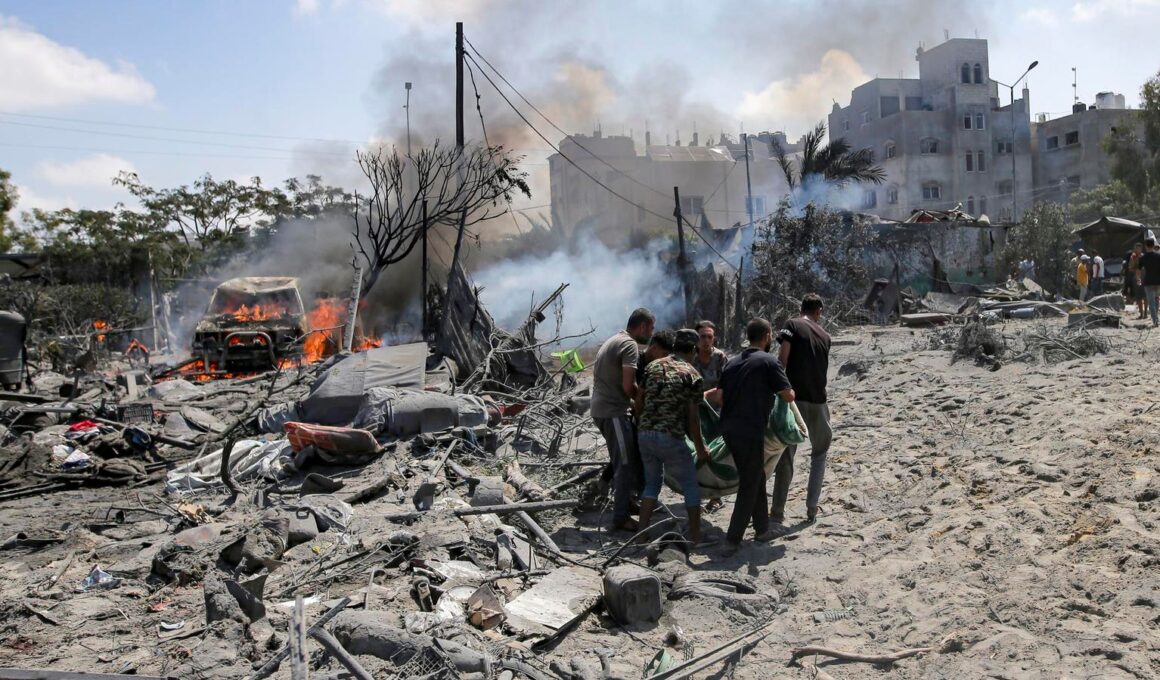Topline
Israeli military forces said Thursday they killed Hamas military leader Mohammed Deif in an operation in mid-July, which would be the highest-ranking Hamas military official to be killed so far in the war, coming just a day after the death of Hamas leader Ismail Haniyeh—though it remains to be seen how the moves will affect ceasefire negotiations.
The aftermath of an Israeli bombardment on Khan Younis, southern Gaza Strip, on July 13, in which … [+]
Key Facts
Deif was killed on July 13, Israel’s Defense Minister Yoav Gallan said on X, describing the Hamas leader as the “Osama Bin Laden of Gaza” and saying his death “is a significant milestone in the process of dismantling Hamas as a military and governing authority in Gaza, and in the achievement of the goals of this war.”
Hamas has not yet confirmed the killing, with a statement by Hamas official Izzat Al Rishq on Telegram quoted by CNN saying unless the group’s leadership announces it, “no news published in the media or by any other parties can be confirmed.”
Israeli officials told CNN they had only just received new intelligence that confirmed Deif’s killing, which the outlet notes took place as part of a strike in a humanitarian zone in the Gaza Strip that also killed 90 Palestinians.
Deif was second-in-command in the Hamas military and is believed to be one of the masterminds behind the October 7 attacks in Israel, saying in a recorded speech Hamas launched the attack so that “the enemy will understand that the time of their rampaging without accountability has ended,” as quoted by The New York Times.
He is also credited with building Hamas into a substantial force, with analyst Ibrahim Madhoun telling the Times, “His fingerprints are on the transformation of the Qassam Brigades from a limited number of armed cells to a formal army that has tens of thousands of fighters.”
Deif had not been seen publicly in years, the Times notes, and the International Criminal Court had ordered an arrest warrant for him and other Hamas leaders in May.
Get Forbes Breaking News Text Alerts: We’re launching text message alerts so you’ll always know the biggest stories shaping the day’s headlines. Text “Alerts” to (201) 335-0739 or sign up here.
News Peg
Israel’s confirmation of Deif’s killing comes directly after news that top Hamas political leader Ismail Haniyeh had been killed in Iran Wednesday. Israel has not taken responsibility for Haniyeh’s death, but Hamas has blamed the move on Israel and decried it as a targeted assassination. (The Associated Press notes Israel does not typically comment on assassinations carried out by its intelligence agency.)
What We Don’t Know
How the killings of Haniyeh and Deif will impact the Israel-Hamas war and ongoing negotiations between the two sides to reach a ceasefire. The AP noted before Israel announced Deif’s death that killing him could make Israel more willing to accept a deal, as the government can point to taking out the military leader as an example of it accomplishing its goals. It also could make Hamas less likely to accept a deal and be seen as admitting defeat, however, analysts cited by the AP pointed out. Haniyeh’s death has also escalated the potential threat of violence in the region, with Iran’s supreme leader Ayatollah Ali Khamenei reportedly ordering Iran to strike Israel in retaliation, according to the Times.
Surprising Fact
Deif’s alleged death comes after the Hamas leader had previously survived at least eight assassination attempts by Israeli forces, the Times reports citing the Israeli military.
Key Background
Israel’s alleged killing of Deif is part of a broader goal by the Israeli military to take out Hamas leadership in retaliation for the attack on October 7 that killed nearly 1,200 people. The country’s military has said it has so far killed more than 14,000 combatants and half of Hamas’ commanders, according to CNN, though the outlet also notes Hamas has been able to rebuild its forces, leading Israeli troops to have to return to areas it previously declared victory over. The deaths of Hamas leaders and combatants come as Israel has retaliated against October 7 with heavy bombardment in Gaza that has led to widespread devastation, leading to condemnation of the Israeli government by pro-Palestinian advocates. Nearly 40,000 people have died so far in Gaza during the war, according to data released Thursday by the Gaza Health Ministry cited by Agence France-Presse.
Further Reading
Hamas Political Chief Ismail Haniyeh Killed In Iran—Militant Group Blames Israel (Forbes)
Muhammad Deif, a Top Hamas Commander, Is Dead, Israel Says (New York Times)
Israel targets Hamas’ military leader in Gaza. Who is he and what does it mean for the war? (Associated Press)
Who is Mohammed Deif, the Hamas commander behind the attack on Israel? (Reuters)
Israeli military says it killed Hamas chief Mohammed Deif in Gaza last month (CNN)









